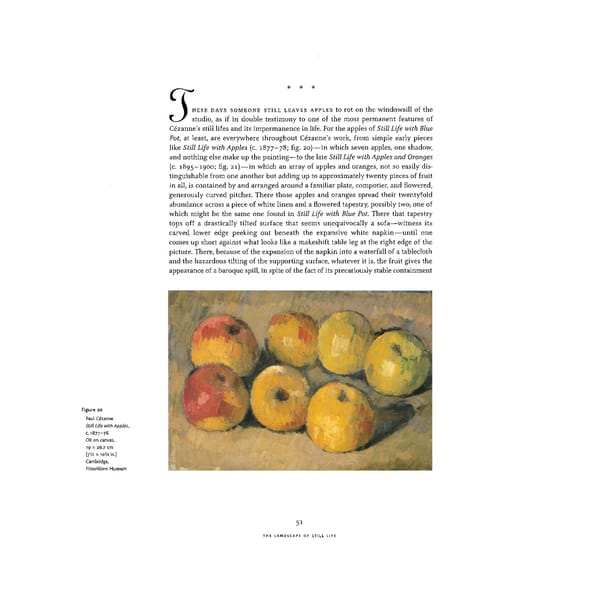HESE DAYS SOMEONE STILL LEAVES APPLES tO TOt On the WindoWSlll OÍ the J studio, as if in double testimony to one of the most permanent features of Cezanne's still lifes and its impermanence in life. For the apples of Still Life with Blue Pot, at least, are everywhere throughout Cezanne's work, from simple early pieces like Still Life with Apples (c. 1877-78; fig. 20)—in which seven apples, one shadow, and nothing else make up the painting—to the late Still Life with Apples and Oranges (c. 1895-1900; fig. 21)—in which an array of apples and oranges, not so easily dis- tinguishable from one another but adding up to approximately twenty pieces of fruit in all, is contained by and arranged around a familiar plate, compotier, and flowered, generously curved pitcher. There those apples and oranges spread their twentyfold abundance across a piece of white linen and a flowered tapestry, possibly two, one of which might be the same one found in Still Life with Blue Pot. There that tapestry tops off a drastically tilted surface that seems unequivocally a sofa—witness its carved lower edge peeking out beneath the expansive white napkin—until one comes up short against what looks like a makeshift table leg at the right edge of the picture. There, because of the expansión of the napkin into a waterfall of a tablecloth and the hazardous tilting of the supporting surface, whatever it is, the fruit gives the appearance of a baroque spill, in spite of the fact of its precariously stable containment Figure 20 Paul Cézanne Still Life with Apples, €.1877-78 Oil on canvas, 19 x 26.7 cm (jVz x ioVz in.) Cambridge, Fitzwilliam Museum 5l THE LANDSCAPE OF STILL LIFE
 Cézanne in the Studio: Still Life in Watercolors Page 65 Page 67
Cézanne in the Studio: Still Life in Watercolors Page 65 Page 67